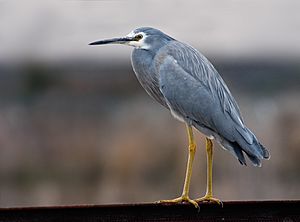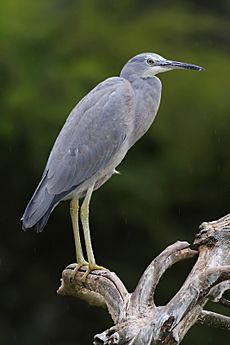White-faced heron facts for kids
Quick facts for kids White-faced heron |
|
|---|---|
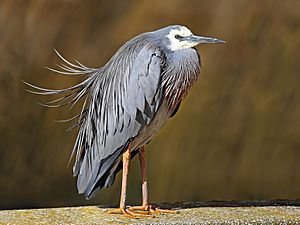 |
|
| The white-faced heron in breeding plumage, in a characteristic resting pose. | |
| Conservation status | |
| Scientific classification | |
| Genus: |
Egretta
|
| Species: |
novaehollandiae
|
| Synonyms | |
|
Ardea novaehollandiae |
|
The white-faced heron (Egretta novaehollandiae) is a common bird found across much of Australasia. You might also hear it called the white-fronted heron. It lives in places like New Guinea, Indonesia, New Zealand, and most of Australia.
This heron is a medium-sized bird. It has a pale, slightly bluish-grey body. Its legs are yellow, and it has white markings on its face. You can spot it almost anywhere there is shallow water. This includes fresh water or salty water. If you disturb it, it will fly away with long, slow wing beats. But it can also be brave enough to visit fish ponds in towns!
Contents
About the White-faced Heron

Scientists first described the white-faced heron in 1790. An expert named John Latham gave it its scientific name. For a while, scientists thought it was related to a different group of birds called Ardea.
Later, other scientists looked closely at its bones. They found that its skeleton was more like birds in the Egretta group. This group includes other types of egrets. So, they decided to place the white-faced heron in the Egretta family. DNA studies later confirmed this idea.
The Ngarrindjeri people, who are Indigenous Australians, call this bird krawli. They live in the Lower Murray region of South Australia.
What Does the White-faced Heron Look Like?
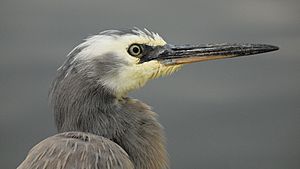
Adult white-faced herons are medium-sized birds. Their bodies are mostly a pale blue-grey color. Their forehead, the top of their head, chin, and upper throat are white. The white on their head can look different on each bird. This helps people tell them apart!
Their eyes can be grey, green, yellow, or cinnamon. The skin between their eyes and beak is black. Their beak is black, but it can be pale grey near the base.
During the breeding season, these birds get special feathers. Pinkish-brown or bronze feathers appear on their neck and chest. Blue-grey feathers also grow on their back.
An adult heron usually weighs about 550 grams (1.2 pounds). It stands about 60 to 70 centimeters (24 to 28 inches) tall.
Younger birds are a lighter grey color. Only their throat is white. They often have a reddish color on their belly. Baby herons are covered in soft grey down feathers.
Where Do White-faced Herons Live?
The white-faced heron lives across most of Australasia. This includes places like New Guinea, the islands of Torres Strait, Indonesia, New Caledonia, and New Zealand. It also lives in almost all parts of Australia, except for the very driest areas.
These birds are now living on Christmas Island. They have also been seen in China and the Solomon Islands. In the Northern Territory of Australia, they mostly visit during winter. The white-faced heron arrived in New Zealand on its own in the late 1940s. It is the only heron that nests in Tasmania.
White-faced herons move around locally. They can be found in many different places. These include fresh and salty wetlands, farm dams, and grassy fields. You might also see them on shores, mudflats, beaches, or even in garden fish ponds! In Australia, this bird is protected by law.
White-faced Heron Behaviour
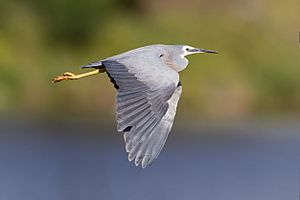
White-faced herons often sit on fence posts, trees, or house roofs. When they fly, their flight is slow and bouncy.
Calls of the Heron
The most common sound a white-faced heron makes is a rough croak. It sounds like graak or graaw. They usually make this sound when flying or when they are interacting with other birds.
When a heron returns to its nest, it might make a gow, gow, gow sound. If they sense danger, they will make loud alarm calls. These can sound like wrank, oooooooooh or aaarrrgh.
Reproduction and Life Cycle
White-faced herons usually breed in the spring in Australia. However, they might breed at other times if there has been a lot of rain. Both the male and female birds work together. They build the nest, sit on the eggs, and care for their young.
The nest is a messy, shallow bowl made of sticks. It is usually placed on a leafy branch. Nests are often 5 to 12 meters (16 to 39 feet) high. When breeding, the birds have long, special feathers on their neck, head, and back.
A female heron usually lays three to five pale blue eggs. Each egg is about 48.5 by 35 millimeters (1.9 by 1.4 inches). They usually raise only one group of chicks each year. The eggs hatch after about 25 days. The parents guard their chicks for 3 to 4 weeks. The young birds are ready to fly about 40 days after hatching. Birds like kookaburras, Australian magpies, hawks, and owls sometimes hunt young herons.
How White-faced Herons Find Food
White-faced herons eat many small water creatures. Their diet includes fish, frogs, small reptiles, and insects. They have several ways to catch food.
Sometimes, they stand very still and wait for prey to move. They might even move their neck in a special rhythm. Other times, they walk slowly in shallow water. They might also flick their wings or rake their feet to stir up food. They can even chase prey with their wings open!
White-faced herons usually hunt alone. Sometimes, they feed in small groups. They might feed in larger groups when it's not breeding season. This is especially true after rain or floods.
See also
 In Spanish: Garceta cariblanca para niños
In Spanish: Garceta cariblanca para niños



